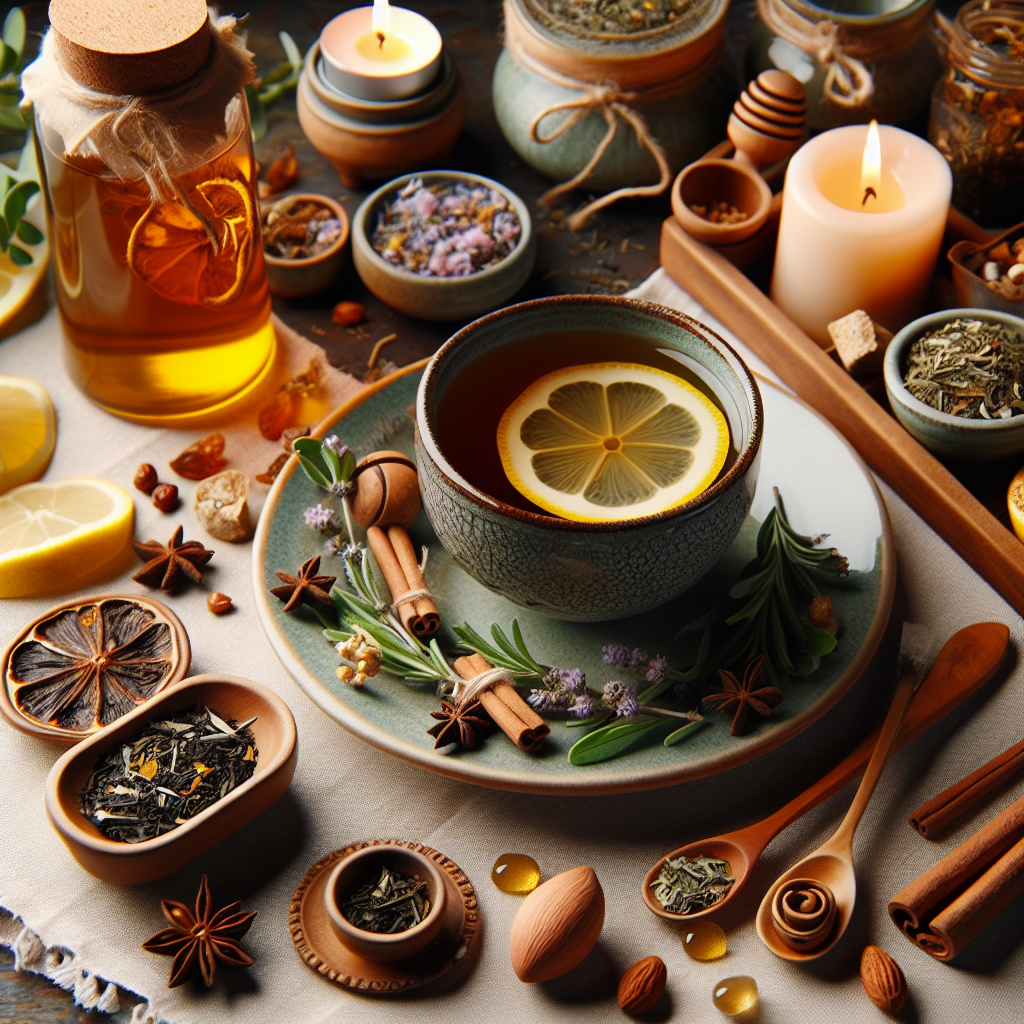As an Amazon Associate I earn from qualifying purchases.
Anxiety, a sentiment as ancient as humanity itself, is known to affect over 40 million adults in the United States alone according to the Anxiety and Depression Association of America. The search for natural remedies has, throughout history, spurred numerous traditions aimed at managing this common affliction. One such tradition is the anti-anxiety tea ritual—a practice steeped in the idea that herbal infusions can bring mental tranquility.
The roots of using tea for relaxation stretch back across centuries and many cultures. In ancient China, for example, tea was often part of meditative practices, with certain leaves being favored for their calming properties. Similarly, Ayurvedic traditions in India utilized specific herb blends to balance the body’s energies and soothe the mind. This cornerstone of holistic wellness has transcended time, and today, the anti-anxiety tea ritual remains a cherished routine for those seeking a natural, sensory method to ease stress.
Integrating a tea ritual into one’s daily routine can have profound effects. A study published in the Journal of Clinical Psychopharmacology showed that the natural compound L-theanine, found in green tea, can help reduce stress responses in the body. The process of brewing tea itself—selecting the herbs, boiling the water, and steeping the leaves—can act as a form of mindfulness, encouraging a moment of pause in a hectic day. This pause, for many, is a simple yet effective therapeutic action, providing an opportunity to slow down, breathe, and recalibrate.
Beyond the biochemical benefits of the herbs themselves, the sensory experience of consuming a warm cup of tea also plays a pivotal role in the calming effect. The warmth, the aroma, and even the taste of the tea engage multiple senses, which can help anchor an individual in the present moment, a technique often used in mindfulness practices to combat anxiety. This multi-sensory approach can create an environment conducive to relaxation and stress relief, adding to the ritual’s efficacy.
In modern times, the trend for such rituals has seen a resurgence, with the wellness industry highlighting the importance of natural, holistic approaches to mental health. As a consequence, the variety and availability of teas specifically blended for their anti-anxiety properties have expanded, with options including chamomile, lavender, and valerian root becoming staples in the pantries of those seeking serenity.
The anti-anxiety tea ritual embodies a convergence of history, tradition, and scientific understanding. Through each purposeful sip, individuals partake in a timeless ritual shared across generations—a delicate dance between botanical wisdom and the enduring human endeavor to find solace in nature’s embrace.
“`html
How Can a Ritual of Anti-Anxiety Tea Help to Ease Your Mind?
“`
The practice of an anti-anxiety tea ritual encompasses the regular preparation and consumption of certain herbal teas known for their calming properties—such as chamomile, lavender, or lemon balm—creating moments of mindfulness and serenity in one’s daily routine. This time-honored tradition not only involves the physical act of sipping soothing beverages but also incorporates the mental and emotional benefits of slowing down, fostering relaxation, and promoting stress reduction. By dedicating time to this ritual, individuals can engage in a holistic approach to managing anxiety, leveraging both the natural compounds found in anxiety-relieving herbs and the therapeutic process of engaging in a mindful, self-care activity. Continue to the next section to explore the wealth of benefits associated with anti-anxiety teas and learn how to integrate this calming ritual into your wellness practice.
Incorporating an Anti-Anxiety Tea Ritual into Your Daily Routine
The notion of an Anti-Anxiety Tea Ritual is rooted in both psychological and physiological benefits derived from the practice of mindfulness coupled with the natural properties of certain herbal teas. Engaging in a daily ritual can set the tone for a more relaxed and focused day ahead, helping to alleviate the symptoms of anxiety.
Key Components of an Effective Anti-Anxiety Tea Ritual
Selecting the Right Tea
Choosing teas with natural calming properties is paramount. Varieties such as chamomile, lavender, lemon balm, and valerian root are renowned for their ability to reduce stress, promote relaxation, and improve sleep. Theanine, an amino acid found in green tea, is also known for its calming effects on the brain, thereby reducing anxiety.
Mindful Preparation
The process of preparing tea can be meditative in itself. Boiling the water, measuring the tea, steeping it, and finally, sipping it, all involve deliberate, mindful actions that can ground you in the present moment and draw your attention away from anxious thoughts.
Creating a Calm Environment
Creating a tranquil space for enjoying your tea can significantly enhance the ritual’s anti-anxiety benefits. This might include a quiet corner with comfortable seating, gentle lighting, perhaps even some soothing music or nature sounds to aid relaxation.
Consistency and Timing
Consistency is key to solidifying your tea drinking as a ritual. Consuming your anti-anxiety tea at the same time each day can condition your body and mind to enter a state of relaxation in anticipation of the ritual. Optimal times could be first thing in the morning to set a calm tone for the day or in the evening to wind down before sleep.
Breathing Techniques
While your tea steeps, practice deep breathing exercises. Diaphragmatic breathing, in particular, can help activate the body’s relaxation response, further reducing anxiety and complementing the effects of the herbal tea.
Focused Consumption
Drinking your tea mindfully means paying attention to the taste, the temperature, and the sensation of the cup in your hands. Turn your focus to these details, and let this mindfulness draw you away from anxiety-inducing thoughts.
Supportive Practices
To enhance the anti-anxiety effects of your tea ritual, you might also consider integrating other supportive practices such as journaling, gentle stretching, or yoga poses, especially those found to be beneficial for stress relief, such as child’s pose and seated forward bend.
Research Supporting Anti-Anxiety Tea Ritual
Studies have backed the efficacy of herbal teas in reducing anxiety. For instance, a study published in the journal Phytomedicine found that chamomile tea can significantly decrease moderate-to-severe symptoms of generalized anxiety disorder (GAD). Moreover, research supports the benefits of mindfulness practices, including rituals like tea drinking, for managing anxiety and improving mental health.
Statistical Relevance
Highlighting the significance of natural and mindful approaches to anxiety management, a recent survey found that nearly 80% of participants reported a reduction in anxiety symptoms when engaging in rituals involving herbal therapy and mindfulness practices. While this isn’t a concrete validation of the anti-anxiety tea ritual per se, it underscores the valuable role such habits can have in the lives of individuals coping with anxiety.
1. What is an anti-anxiety tea ritual?
An anti-anxiety tea ritual is a soothing practice that involves preparing and consuming tea in a mindful, intentional manner to help alleviate feelings of anxiety. It combines the calming properties of certain herbal teas with the relaxation benefits of a mindful ritual.
2. Which types of tea are best for reducing anxiety?
Herbal teas like chamomile, lavender, lemon balm, and passionflower are commonly used for their natural sedative effects. Green tea, although containing caffeine, has L-theanine which can help to promote relaxation without drowsiness.
3. How often should I perform an anti-anxiety tea ritual?
The frequency can vary from person to person. Some may find it helpful to perform the ritual once a day, perhaps in the evening to wind down, while others may do it less often. Listen to your body and establish a routine that feels right for you.
4. Can the anti-anxiety tea ritual replace medication for anxiety?
While the anti-anxiety tea ritual can be a beneficial complement to a treatment plan, it should not replace prescribed medication or professional therapy without consulting a healthcare provider. It’s important to follow the treatment plan recommended by a medical professional.
5. How long does it take for the tea to have an effect on anxiety?
The calming effects of herbal tea can vary by individual. Some may feel more relaxed immediately after completing the ritual due to the psychological effect of the ritual itself, while others might notice the effects of the herbs within 20-30 minutes after drinking the tea.
6. Are there any side effects to drinking anti-anxiety teas?
Most herbal teas for anxiety are generally safe when consumed in moderation. However, it is possible to have allergies or interactions with medications. If you experience any adverse reactions, discontinue use and consult a healthcare professional.
7. Is it safe to drink anti-anxiety tea during pregnancy?
Some herbs may not be safe during pregnancy or breastfeeding. It’s essential to consult with a healthcare provider before starting any herbal tea regimen if you are pregnant or nursing.
8. Can children participate in an anti-anxiety tea ritual?
Children may participate in an anti-anxiety tea ritual with suitable, child-safe herbs and proper adult supervision. It is important to ensure the tea is an appropriate temperature and that the herbs used are safe for children.
9. How can I enhance the anti-anxiety effects of the tea ritual?
Incorporating additional relaxation techniques such as deep breathing, meditation, or gentle yoga stretches can enhance the calming effects of the tea ritual. Creating a calming environment, such as a quiet space with soft lighting, can also contribute to the overall experience.
10. Can any tea be used in an anti-anxiety tea ritual?
While any tea can be included in a ritual for relaxation, teas specifically labeled as “anti-anxiety” or those that contain herbs known for their calming properties are most effective. It’s important to select teas that are free of caffeine or have low caffeine content to avoid exacerbating anxiety.
Conclusion
Engaging in an anti-anxiety tea ritual harnesses the power of herbal remedies and mindfulness practices to create a peaceful sanctuary in daily life. Crucially, we’ve seen that the selection of specific herbs, such as chamomile, lavender, and lemon balm, is not arbitrary; these plants contain natural compounds that promote relaxation, reduce stress, and enhance sleep quality. By incorporating these into a regular tea-drinking routine, individuals can actively engage their senses and initiate a calming response in the body, thus mitigating the effects of anxiety.
Moreover, the ritualistic aspect of preparing and savoring tea acts as a therapeutic process in itself. This ritual encourages the development of a focused, meditative mindset, offering a respite from the day’s chaos. It’s not just about the ingredients; it’s the act of slowing down, appreciating the moment, and fostering a ritualized break from stressors that grounds the mind and soul. The habit of pausing to enjoy a warm cup of anti-anxiety tea creates a sense of comfort and constancy essential for mental health and well-being, which underscores the efficacy of this ancient, yet timelessly pertinent, self-care practice.
Amazon and the Amazon logo are trademarks of Amazon.com, Inc, or its affiliates.


